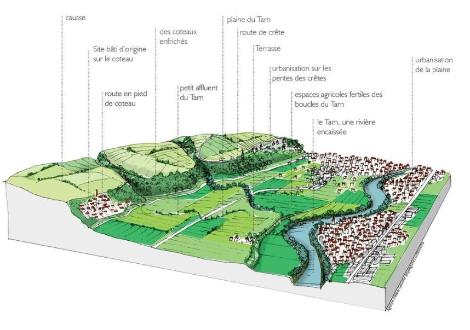The landscape approach for transition
Chaire Paysage et énergie (ENSP), 2022
The implementation of a sustainable spatial planning policy requires good management of « everyday » landscapes, which guarantees access for all to a quality living environment. In this context, the strengthening of the consideration of landscape in public policies is a major challenge. Indeed, landscape transformations are mainly linked to the different development policies implemented on a territory.
What is the landscape approach?
Some speak of landscape project, others of landscape approach. Whatever the formula, the idea is the same: the landscape approach is an innovative planning and urbanism method that can be summarized in five points:
1. Taking into account the sensitive reality of the territory at stake:
the territory is not only an objective data devoid of any sensitivity: it is perceived and lived by the populations. The landscape approach takes this sensitivity into account by paying attention to the existing situation, to physical data, to ecosystem functions, but also to perceptions, uses and representations, all of which take the form of the shared expression of landscape values; no more purely quantitative approaches.
2. Cross-cutting and holistic approach:
the landscape approach places the qualitative ambition for the landscape as a common good at the heart of the interests, thus crossing all the sectorial fields of the planning: economic (attractiveness of the territories, tourism, quality of the working environment), social (social links, physical and mental health, leisure) and environmental; no more siloed approaches.
3. Taking into account the living world in its entirety:
living human beings are not separated from living non-human beings in the reflection: the uses of the inhabitants are integrated into the approach, as is the ecological functioning of living non-human beings (animals and plants) and natural elements or phenomena; no more exclusive approaches, sociological on the one hand and ecological on the other;
4. Participatory approach:
the landscape approach, non-technical, speaking for all, gives all its place to the expression of the sensitivities of the populations in their diversity: elected representatives, technicians, companies, associations, professionals. It bets on collective intelligence in the service of a common good. No more top-down and technocratic approaches.
5. Creativity:
landscape design identifies and recognizes the irrepressible character of the transformations of the frameworks and ways of life, but proposes to choose them rather than to undergo them, in a demanding, creative and operational way, through the effective transformation of spaces, places and living environments. No more fixed conservative or purely theoretical ideological positions.
